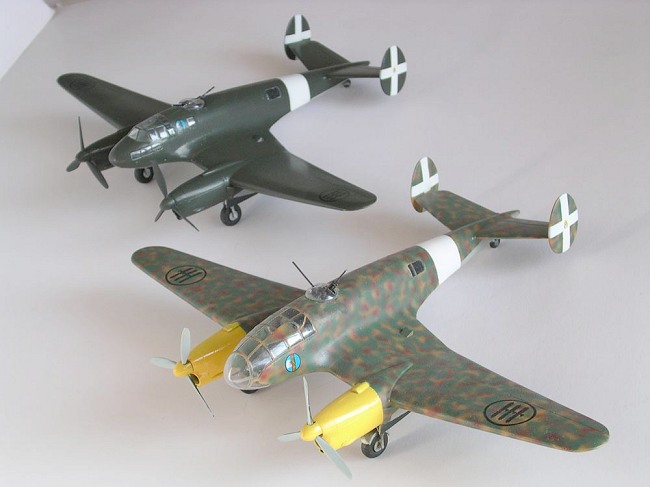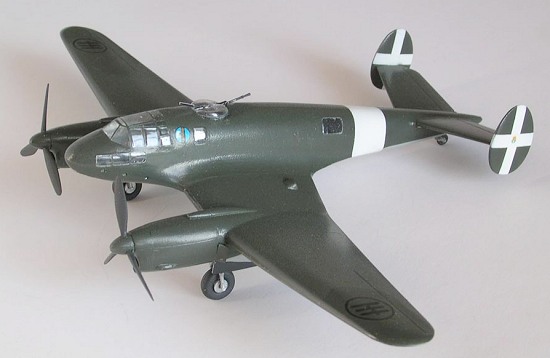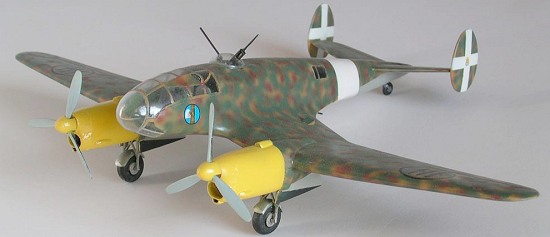
LF Models 1/72 Caproni Ca.331 OA/CN
| KIT #: | 7251/7252 |
| PRICE: | $55.00 MSRP each |
| DECALS: | One option |
| REVIEWER: | Chris Busbridge |
| NOTES: | Resin kits purchased direct from LF Models |

| HISTORY |
In 1938 a new project was started by Caproni, in response to an Air
Ministry requirement for an aerial observation aircraft. The first Ca.331
protoype was the O.A. (Osservazione Area) variant and was of all metal
construction, a new departure from Caproni's better known fabric and
plywood covered aircraft such as the Ca.311, Ca.313 & Ca.314 series. What
is not in  dispute is the pure clean lines of this aircraft, perhaps one of
the prettiest Italian aircraft of World War II. It was a good
aircraft too. When it first few in 1940, all the pilots who had the chance
to fly it were unanimous in their praise, it even prompted a German pilot
to remark "kolossal gut" at the end of a fight. The only serious fault was
the choice of propellers. Originally fitted with Piaggio blades, it was
re-equipped with Alfa Romeo units in 1941, which immediately gave better
results. Werner Molders test flew it at one time and Goering was treated to
a spirited flying display during his visit to the Guidonia airfield in Jan
1942. In fact, it was the Germans who were more serious about getting the
aircraft into production. Eventually the O.A. prototype was revised to the
C.N. (Caccia Notturno) configuration, which destroyed the lines
somewhat.
dispute is the pure clean lines of this aircraft, perhaps one of
the prettiest Italian aircraft of World War II. It was a good
aircraft too. When it first few in 1940, all the pilots who had the chance
to fly it were unanimous in their praise, it even prompted a German pilot
to remark "kolossal gut" at the end of a fight. The only serious fault was
the choice of propellers. Originally fitted with Piaggio blades, it was
re-equipped with Alfa Romeo units in 1941, which immediately gave better
results. Werner Molders test flew it at one time and Goering was treated to
a spirited flying display during his visit to the Guidonia airfield in Jan
1942. In fact, it was the Germans who were more serious about getting the
aircraft into production. Eventually the O.A. prototype was revised to the
C.N. (Caccia Notturno) configuration, which destroyed the lines
somewhat.
The second prototype, built not long after the O.A., was a purpose built C.N.. A third prototype was built but suffered the cruel fate of being used as a source of spares. All were commandeered by the Germans after the 1943 Armistice. They were soon to be scrapped after being found unserviceable. Sadly this fine looking aircraft never saw production.
| THE KIT |
 These resin kit are a rather simplified interpretation of the aircraft,
with no surface panelling as such... just the control surfaces were
engraved. The internal detail is rather basic or non existent, the O.A.
cockpit detail was very similar to the one used in the Italeri Ca.311 kit.
The gull wings are solid cast, as are the engine cowls. The various vac
canopies, of which only one of each is supplied, seemed OK. Their accuracy
could not be gauged until construction had started in earnest. Anyone
contemplating this model would do well to track down a copy of the Jan-Mar
2001 (issue 76) of Aerofan. It includes an in depth article of both of
these aircraft. Typically, I only found this out when I had finished the
O.A. model!
These resin kit are a rather simplified interpretation of the aircraft,
with no surface panelling as such... just the control surfaces were
engraved. The internal detail is rather basic or non existent, the O.A.
cockpit detail was very similar to the one used in the Italeri Ca.311 kit.
The gull wings are solid cast, as are the engine cowls. The various vac
canopies, of which only one of each is supplied, seemed OK. Their accuracy
could not be gauged until construction had started in earnest. Anyone
contemplating this model would do well to track down a copy of the Jan-Mar
2001 (issue 76) of Aerofan. It includes an in depth article of both of
these aircraft. Typically, I only found this out when I had finished the
O.A. model!
| CONSTRUCTION |
The construction diagrams were easy to follow. First off, I removed all parts from their casting blocks before starting any construction. The leading edges of each wing were tidied up, as were the tail surfaces. The fuselage halves had very thick walls, so to get some kind scale appearance to the openings, I thinned them around each aperture. The large cockpit opening allows the liberty of assembling aircraft before any cockpit detailing is done. After the two halves were glued together, the wings and tail surfaces were then glued in place, always checking for alignment. The same applied to the engine cowlings and wheel well bays, their alignment was a bit of an issue too. The spinners and blades were rather nondescript, matching neither the Piaggio or Alfa Romeo units. I used the Italeri Ca.314 parts as replacement, which were a good match for the Alfa Romeo props. Incidentally, the Piaggio props had more conical spinners.
 The instructions failed to describe the undercarriage units having a
slightly rearward tilt. I made new support struts, the resin parts being
very weak. I also made new axles to help support the models weight. The
undercarriage doors, the upper wing vents and lower wing intakes were also
fixed in place. The fairing situated on the top of the engine cowl was made
shorter on the O.A., as LF Models have based it on the longer C.N. type. At
last the cockpit detail was installed, the interior given a coat of
Interior pale green paint, the seats painted silver with black leather
cushions. The control column was silver and the instrument binnacle black.
The instructions failed to describe the undercarriage units having a
slightly rearward tilt. I made new support struts, the resin parts being
very weak. I also made new axles to help support the models weight. The
undercarriage doors, the upper wing vents and lower wing intakes were also
fixed in place. The fairing situated on the top of the engine cowl was made
shorter on the O.A., as LF Models have based it on the longer C.N. type. At
last the cockpit detail was installed, the interior given a coat of
Interior pale green paint, the seats painted silver with black leather
cushions. The control column was silver and the instrument binnacle black.
The moment I had been dreading finally arrived. Will the large O.A. canopy fit? The answer was yes, but only after a struggle. The largest part was the top piece and much test fitting was carried out before a reasonable fit was achieved. Filler was used to smooth the final join. The smaller lower part was just as hard to align and fit. The small dome on the front was the last part. Other vac form items included the lower gondola and mid fuselage windows. Although the C.N. had a more conventional canopy arrangement, in some respects it was even harder to do, there being 8 windows to install, all requiring much trimming to get a reasonable fit and a touch of filler to blend into the fuselage contours. It was with much relief that I was finally able to mask all the canopies/windows and give the models their first coat of primer.
Any flaws were dealt with before starting the camouflage. The worst offender being a very poor join line all along the lower fuselage and a slight mismatch between the wing to fuselage join. The upper turrets were installed after the camouflage was completed.
| COLORS & MARKINGS |
 Although these were prototypes only, there is still a choice... of sorts.
The Piaggio propped O.A. aircraft did not have yellow engine cowlings.
First colour down was the white for the fuselage band, rudder crosses and
for the O.A., a base for the yellow cowlings, using Humbrol Satin White.
The white areas were masked and Humbrol 69 sprayed on the O.A. cowls. These
were masked, then Xtracolor X134 grey sprayed onto all lower surfaces. The
demarcation lines were masked off and for the O.A. upper camouflage Humbrol
63 was used as a base for dense mottle of
Although these were prototypes only, there is still a choice... of sorts.
The Piaggio propped O.A. aircraft did not have yellow engine cowlings.
First colour down was the white for the fuselage band, rudder crosses and
for the O.A., a base for the yellow cowlings, using Humbrol Satin White.
The white areas were masked and Humbrol 69 sprayed on the O.A. cowls. These
were masked, then Xtracolor X134 grey sprayed onto all lower surfaces. The
demarcation lines were masked off and for the O.A. upper camouflage Humbrol
63 was used as a base for dense mottle of
Humbrol 149 and 18, which was done freehand. The C.N. was an overall Olive
green for which I used Xtracolor X109. Black was brush painted on to the
base of each engine cowl and half of each undercarriage door (to hide
exhaust staining). Not all decals from the sheet were used. The wing
roundels were too small for the O.A.
| CONCLUSIONS |

This is a surprising choice of subject matter and a welcome one. The O.A. is definitely a contender in the beauty stakes as far as I'm concerned. I guess it would be churlish to criticize LF's models to any degree. As the saying goes "never look a gift horse in the mouth" even if it was an expensive one. I would even consider building another O.A., as I'm sure I could to a better job second time around.
| REFERENCES |
Aerofan Jan-Mar 2001 (Issue 76)
February 2005
Copyright ModeingMadness.com
If you would like your product reviewed fairly and quickly, please contact the editor or see other details in the Note to Contributors.